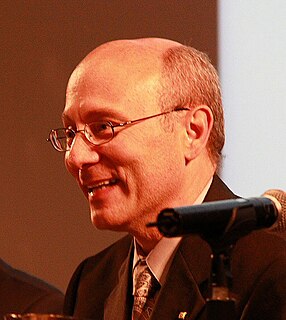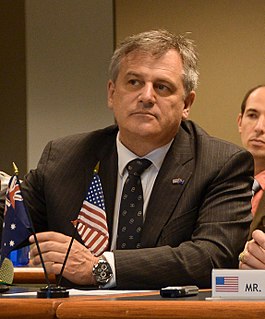Defence Science and Technology is part of the Australian Department of Defence dedicated to providing science and technology support for Australia's defence and national security needs. It is Australia's second largest government-funded science organisation after the CSIRO. The agency's name was changed from Defence Science and Technology Organisation (DSTO) to Defence Science and Technology on 1 July 2015.

The Defence Science and Technology Laboratory (Dstl) is an executive agency of the Ministry of Defence of the United Kingdom. Its stated purpose is "to maximise the impact of science and technology for the defence and security of the UK." The agency is headed by Gary Aitkenhead as its Chief Executive, with the board being chaired by Sir David Pepper.. Ministerial responsibility lies with the Minister for Defence Procurement.
Hugh Francis Durrant-Whyte is a British-Australian engineer and academic. He is known for his pioneering work on probabilistic methods for robotics. The algorithms developed in his group since the early 1990s permit autonomous vehicles to deal with uncertainty and to localize themselves despite noisy sensor readings using simultaneous localization and mapping (SLAM).
The Office of the Chief Scientist (OCS) is part of the Department of Industry, Innovation and Science. Its primary responsibilities are to enable growth and productivity for globally competitive industries. To help realise this vision, the Department has four key objectives: supporting science and commercialisation, growing business investment and improving business capability, streamlining regulation and building a high performance organisation.

Alan Simon Finkel is Australia's Chief Scientist. An Australian neuroscientist, engineer, entrepreneur and philanthropist, he served as Chancellor of Monash University in 2008-2016.

Robin John Batterham AO FREng FAA FTSE is an Australian scientist specialising in chemical engineering. He was the Chief Scientist of Australia from 1999 to 2006.
John Wilcox Stocker AO is an Australian immunologist and the former Chairman of the Board of the Commonwealth Scientific and Industrial Research Organisation (CSIRO), the national government body for scientific research in Australia. Stocker is a former Chief Scientist of Australia.

Henrique "Rico" S. Malvar is a distinguished Brazilian engineer and a senior signal processing researcher at Microsoft Research's largest laboratory in Redmond, Washington, United States. He was the Managing Director of the lab following the departure of long-time Managing Director Dan Ling in 2007, and oversaw about 350 researchers. Currently, he is the Chief Scientist of Microsoft Research.
John Riley is an Australian scientist at the Defence Science and Technology Organisation and former Australian rules footballer who played with Footscray in the Victorian Football League (VFL) and North Adelaide in the South Australian National Football League (SANFL).

Vijay Kumar Saraswat is an Indian scientist who formerly served as the Director General of the Defence Research and Development Organisation (DRDO) and the Chief Scientific Advisor to the Indian Minister of Defence. He retired on 31 May 2013 and presently member of NITI Aayog i.e. Planning Commission of India and Chancellor of Jawaharlal Nehru University.

Alexander "Alex" Zelinsky, is an Australian computer scientist, systems engineer and roboticist. He was the Chief Defence Scientist of Australia from March 2012 until November 2018. His career spans innovation, science and technology, research and development, commercial start-ups and education. As Chief Defence Scientist he led Defence Science and Technology for Australia's Department of Defence. Since November 2018, he has been Vice-Chancellor and President of the University of Newcastle.
Vallampadugai Srinivasa Raghavan Arunachalam is an Indian scientist. He is the founder and Chairman of CSTEP, a science and technology think tank.

Malur Ramasamy Srinivasan, is an Indian nuclear scientist and mechanical engineer. He played a key role in the development of India's nuclear power programme and the development of the PHWR. He received the Padma Vibhushan Award.
Dr. Roger Lough is an Australian Defence scientist. He was Chief Defence Scientist from 2003 to 2008. Prior to this appointment he had been director of the Platform Sciences Laboratory within the Defence Science and Technology Organisation (DSTO) since January 2002.
Robert (Bob) Clark is an Australian physicist. He was appointed Professor and Chair of Energy Strategy and Policy at University of New South Wales (UNSW) in 2012. Prior to this he was Chief Defence Scientist from 2008 to 2011 and Professor of Experimental Physics at University of New South Wales, where he established the National Magnet Laboratory and Semiconductor Nanofabrication Facility.

Ramadas Panemangalore Shenoy was an Indian defence scientist and writer, known for his contributions in the field of Radar technology. He secured a doctoral degree in Electrical Engineering from the University of Wisconsin–Madison and joined Defence Research and Development Organization in 1961, involving himself with the indigenous development of Radar technology till his retirement, as a Distinguished Scientist, in 1989.

Dr G. Satheesh Reddy is an Indian Aerospace Scientist and the current Chairman of Defence Research and Development Organisation (DRDO) and Secretary, Department of Defence R&D, Government of India and Director General, Aeronautical Development Agency (ADA). In June 2015 he was also appointed as a scientific adviser to the defence minister of India. Satheesh presently heads Dr APJ Abdul Kalam Missile Complex. Satheesh is the Chief Architect of India's Mission Shakti Anti Satellite Missile Test (ASAT) and led the entire launch operations. An acclaimed navigation specialist, Reddy personally led the development of systems that guide a missile, itself travelling at hypersonic velocity, to a satellite 300 km away that is travelling through space at almost 30,000 km per hour and achieved a direct hit with centimeters of accuracy.
Manohar Lal Munjal is an Indian acoustical engineer, honorary professor, and INSA senior scientist at the Facility for Research in Technical Acoustics (FRITA) of the Indian Institute of Science. He is known for his studies on aeroacoustics and finite wave analysis of exhaust systems. He is an elected fellow of all the three major Indian science academies viz. Indian Academy of Sciences, Indian National Science Academy, National Academy of Sciences, India as well as the Indian National Academy of Engineering. He has published three books viz. Noise and Vibration Control, Acoustics of Ducts and Mufflers With Application to Exhaust and Ventilation System Design, and IUTAM Symposium on Designing for Quietness and has contributed chapters to books edited by himself and others. The Council of Scientific and Industrial Research, the apex agency of the Government of India for scientific research, awarded him the Shanti Swarup Bhatnagar Prize for Science and Technology, one of the highest Indian science awards for his contributions to Engineering Sciences in 1986.
Janis Louise Cocking is an Australian metallurgist serving as Chief Science Strategy and Program at Defence Science and Technology Group, a branch of the Department of Defence.
The M. A. Sargent Medal is awarded by Engineers Australia for longstanding eminence in science or the practice of electrical engineering. It is named in honour of Michael Anthony (Mike) Sargent, an outstanding Australian electrical engineer. The medal is the highest award of the Electrical College board of Engineers Australia,










